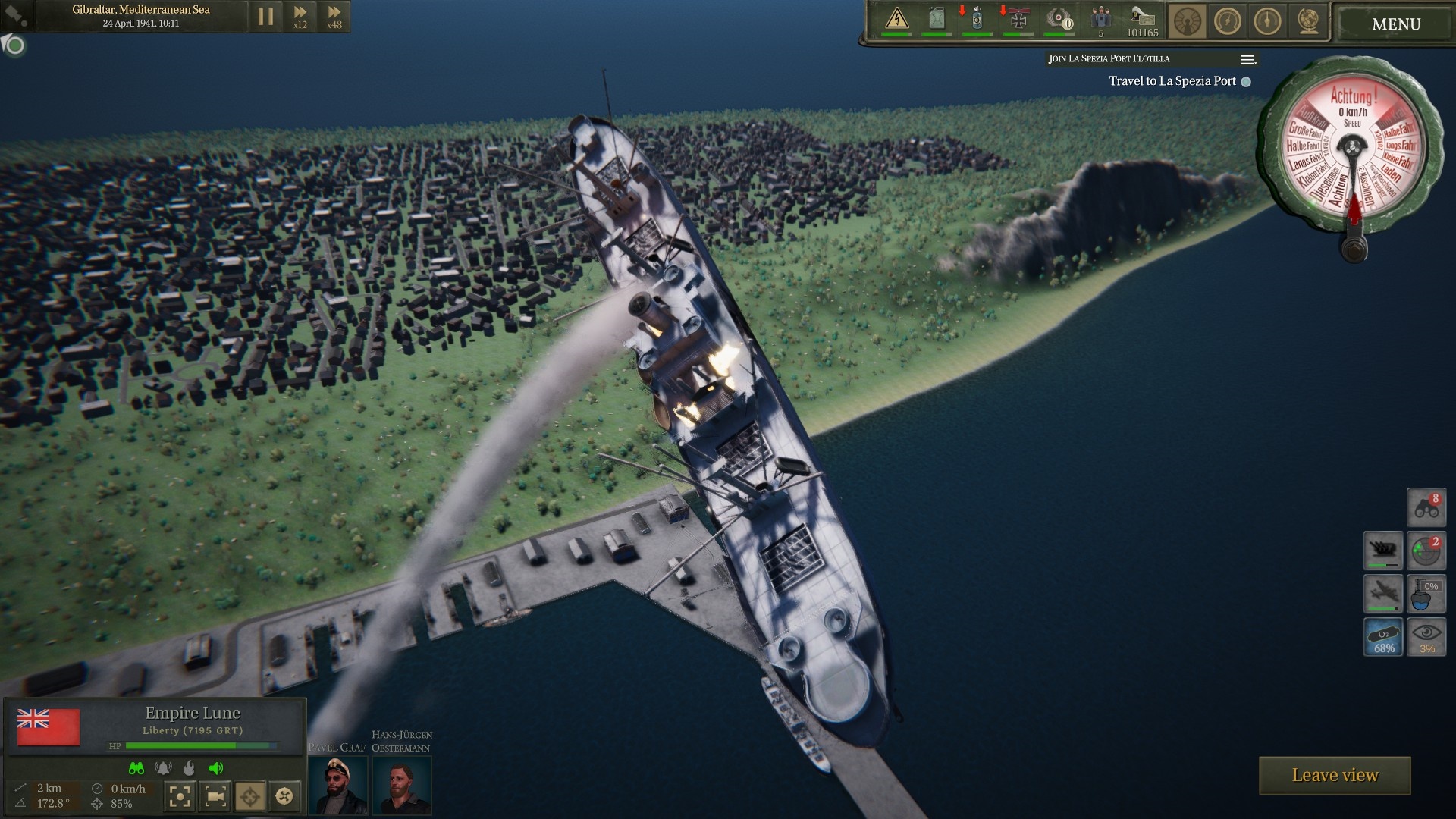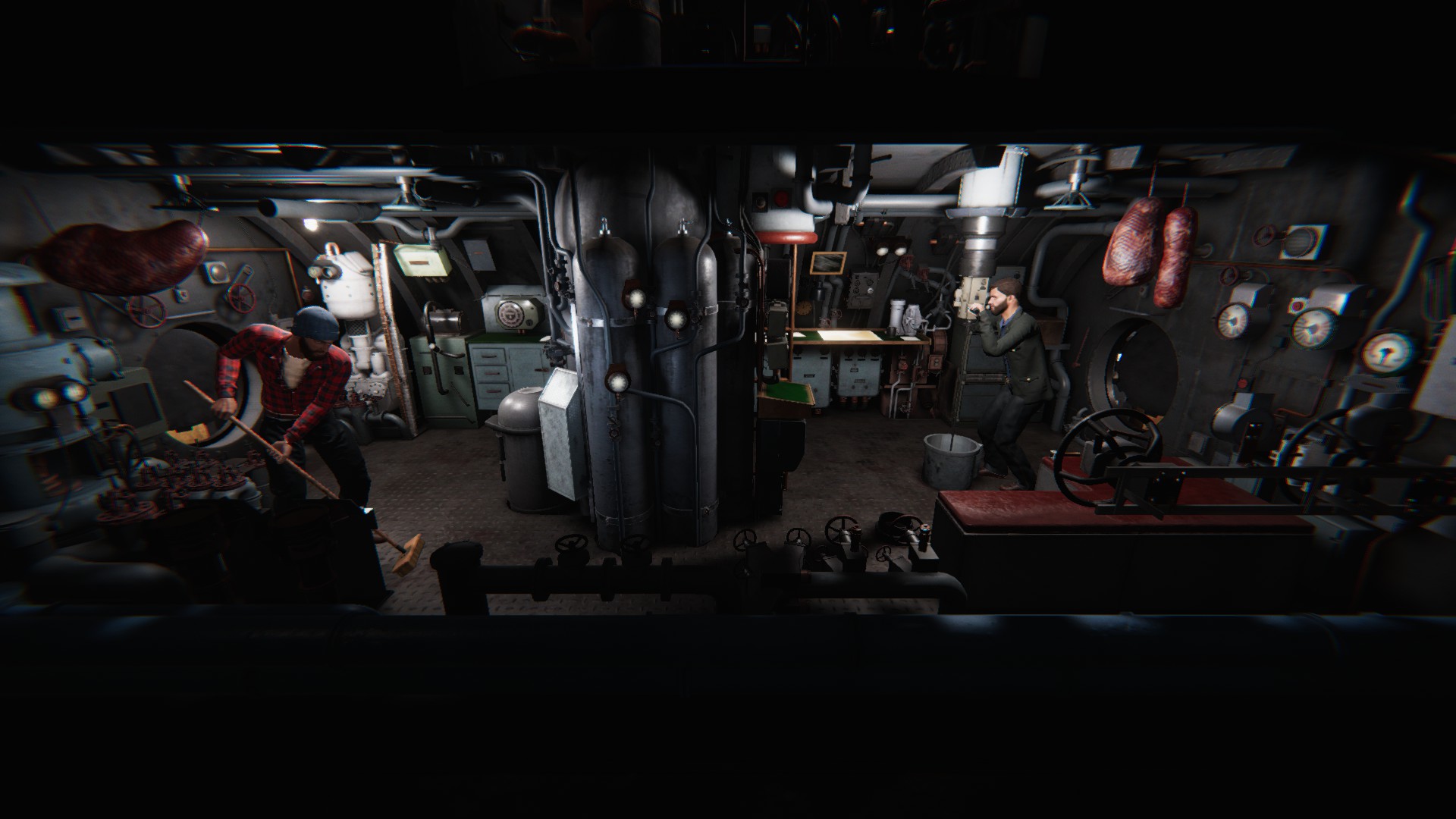From their very first combat deployment in the American War of Independence, when the tiny Turtle tried and failed to attach explosives to the hulls of British warships, submarine warfare has always been a dicey prospect. It wouldn’t be until the American Civil War nearly a century later that the Confederate Navy’s H. L. Hunley would destroy an enemy vessel and, even then, it was lost in the process. From the beginning, then, combat submariners faced high-risks and low survival odds.
Hence why UBOAT has chosen to make crew management and morale as much a part of the undersea experience as calculating torpedo trajectories or running silent and deep. Currently navigating Early Access, this Second World War submarine simulation follows many of the genre’s classic conventions, while also aiming to offer a more intimate angle on the conflict. Between stalking convoys and avoiding the portentous progress of sonar pings, UBOAT is busy reminding its players that history’s submariners shared bunks, worked long shifts without natural light or clean air, and ate rations prepared in a galley five feet wide. It wants to emphasize how, for German crews in particular, submarine warfare was an experience both increasingly miserable and increasingly deadly as the war progressed. Supplies were dwindling. Allied anti-submarine tactics and technology were ever improving. By the end of the conflict, three quarters of all U-boat crews had been lost in action, giving the service the highest casualty rate of any German fighting force.
Videos by VICE
This subject has always translated well to simulation games, the arc of the war itself providing a natural difficulty curve (or even cliff) that can be smoothed or steepened with various realism settings. Many simulation gamers remember the late 80s and 90s as the heyday of submarine games, during which the majority of the genre’s conventions were laid down by a whole fleet of enduring PC titles that included the Silent Service games, Aces of the Deep, 688 Attack Sub and the first Silent Hunter. These simulations firmly established submarines as the fragile assassins of the undersea, essentially glass cannons capable of the most lethal strikes yet also as vulnerable as they were deadly. In Second World War settings in particular, these games offered arguably the pinnacle of the asymmetric cat-and-mouse combat that pitched stealth against strength, surprise against sonar.

UBOAT is all this all over again, but also tossing morale, stress and crew rotations into the mix. As well as offering all the same well-worn stations to switch between, such as the navigator’s maps, the spotter’s periscope or the salt-splashed deck gun, it also features a roster with duty shift and team assignment options. It even allows its captains to walk, pan and peer through the interior of their vessels in first person, rifling through supplies, checking on their fellow sailors or watching as leaky compartments flood about them.
Hopefully, those sailors are all working hard, but sometimes they really aren’t. UBOAT’s crew management mixes hints of XCOM with a sprinkling of The Sims, dividing crewmen into officers, who have specific abilities, and sailors, who are generalists. Sailors can be assigned to different rotating shifts, which then run mostly automatically, or to help specific officers. Officers are managed in a Sims-like fashion and can be sent around the boat to take stations such as the hydrophone, switch equipment on and off, or redistribute supplies. Again, like Sims, they’re able to keep themselves busy with default tasks if they aren’t micromanaged, but are also equally capable of deciding to go to bed at the worst possible time, hitting the sack just as you creep up on an enemy convoy. Officers can gain experience from actions such as performing first aid, or assisting in the successful torpedo attack, and in time they unlock new abilities that speed their work or raise morale. Crewmen, meanwhile, are almost entirely automated, but can be idle and inefficient when officers aren’t around, as well as prone to manifesting spontaneous quirks under pressure. When their mettle is tested by extended time underwater, injuries or relentless depth charge attacks, crewmen can panic or make too much noise, endangering the whole vessel. Achieving objectives such as sinking enemy ships can provide a huge morale boost, but much of the time the crew’s mood is slowly souring thanks to a combination of anxiety and fatigue. This is where the dinner menu might just make all the difference.
All of this crew and resource management presents itself before any sailing even commences, with UBOAT tasking new captains to provision and prepare their vessel by moving around a port that offers mission selection, recruitment and resupply options. Fresh-faced sailors (who can be customized down to their shirt style) line up for assignment, while a dockside warehouse stocks armaments, medical supplies and even a selection of food. The boat can be fueled up and armed with a variety of shells and torpedoes, providing these armaments are available, and an envoy from the Kriegsmarine presents a choice of missions. It’s immediately apparent from many of these that sinking enemy ships will only be part of a captain’s duties, as some assignments involve offloading spies, infiltrating enemy ports, sending a team ashore or even transporting Buchheim-style war correspondents.

And all those aforementioned snacks might be important, with fresh fruit or salted meat more likely to cheer a crew than another sack of potatoes, but again these might be limited according to Germany’s current fortunes and the captain’s own reputation. As is convention with a lot of historical sims and wargames with a “career” mode, reputation is a currency that can be spent both to acquire new material, personne, or upgrades. With any luck, a little extra time in port may see local supplies replenished and a chance to spend more of that reputation, but if the war’s going badly no amount of goodwill and prestige will conjure diesel out of thin air.
After filling all available cupboards with everything from dried fish to diving suits, it’s time to head out into the open sea and this is where UBOAT presents all those more familiar facets, so much so that it’s almost an exercise in nostalgia to fall into a war patrol routine. Long periods of downtime out on the empty, open ocean demand a generous application of time compression and soon many long days and dark, cold nights are lost ploughing through the surging waves of the Atlantic or the North Sea.
UBOAT’s various campaigns begin between 1941, toward the end of what the Germans plainly dubbed their “First Happy Time” when Allied fleets were under-equipped and vulnerable to the undersea threat, and late 1944, when Europe was being retaken and Axis territory was ever dwindling. In the first period, a single roaming U-boat could (and often would) sink several vessels during one patrol, returning home to a rapturous reception. By the latter, U-boats could be harried from the moment they left port, studiosly tracked on radar whenever they surfaced, and extremely vulnerable from the sea and air. If a simulation is to be faithful, that difficulty curve absolutely should become a cliff. The Third Reich is ultimately doomed, and so are most of its vaunted submarines.

At this stage in its development, UBOAT isn’t quite convincing. Late-war campaigns certainly present better-defended convoys, adding more destroyers and even aircraft, all engaging in what seems to be a more active hunting of your boat. Still, my current impression is that the difficulty comes as much from the weight of numbers as any cannier methodology employed by the AI. Sneaking into the British naval base of Scapa Flow in 1945 presented no more challenge than slowly mounting submarine nets as if they were a speed hump, and it was only after torpedoing an enemy vessel inside the base that I found a dozen others chasing me. Even then, they felt clueless and confused in their patrolling, taking hours to find me puttering around in the shallow waters. At the same time, while port resources were a little scarcer, there was no sense that my crew were any more war-weary, dejected or demoralised by the Allied avalanche across Europe. Every late game war patrol began to follow the same pattern and there were always supplies and holidays in France available for my crew when we returned home. Even after France had been liberated by the Allies.
After one long night of playing, it occurred to me to check the date. It was late May and Nazi Germany was supposed to have surrendered weeks ago. I set the game’s free-roving camera to follow another of my torpedoes as it rammed into the hull of a Norwegian freighter.
Even without the campaigns feeling coherent or substantial enough, stalking and striking at enemy convoys is still gratifying; the day-to-day creeping and combat of UBOAT is a fairly satisfying affair, if a little buggy. There’s the careful approach and the calculating of torpedo trajectories, which become ever more certain the longer you assign officers to the task, the sudden strike and then the attempt to evade and escape. Even the best attacks aren’t without complications and the first time a dud torpedo thuds against the hull of an enemy vessel is a stark reminder that nothing can be taken for granted. And while many submarine simulations have rewarded players for taking to the deck gun and shooting it out, in UBOAT this is not always effective, particularly amongst the lurching waves of rough weather. Defending against aerial attacks is also difficult and can make aircraft even more intimidating than warships. One of the best guarantees of success is to remain underwater in all but the safest situations, relying on a classic brace of torpedoes launched with a slight spread.

Bugs surface at the most unexpected times, and can vary from entire fleets stopping in their tracks to a cruiser just three hundred meters away winking out of existence. Navigating my way in first-person toward one injured comrade, I was unable to administer first aid or even select his body, in spite of how vigorously it flailed and flopped in front of me. After shooting down a plane that had the temerity to attack just as I left my home port, I was surprised to watch it rebound around the nearby docks, burning and bouncing. Occasionally, the entire coast of Norway would pop into existence at worryingly close range.
UBOAT’s development history is a slightly unusual one, beginning with a Kickstarter campaign in 2017 that had the remarkably low target of $20,000 Canadian ($15,750 USD), a tiny sum for an ambitious game. It’s been in Early Access since a very buggy spring 2019 release and though the past two years have seen regular updates and improvements, I’m still encountering all sorts of starkly strange behaviour, including wobbly AI, glaring graphical glitches, and an enemy freighter spiralling thousands of feet into the air above the Rock of Gibraltar after a successful torpedo hit. It occasionally crashes to desktop and can sometimes perform remarkably poorly for a game with modest graphics, which includes extremely barren terrain and some ugly menus. Mid-way through writing this feature, a substantial update was released (version B129), which the development team has suggested may be their penultimate, and this rendered my previous saves unusable. I launched a new campaign in 1944 and my skipper was immediately presented with newspapers announcing the declaration of war against the United States and the invasion of the USSR, both events from 1941.
UBOAT is also a starkly de-Nazified game. The officers your skipper interacts with offer regular salutes, not fascist ones, there are no swastikas anywhere in sight and I’ve yet to come across any mention of either Hitler or National Socialism. The game is happy to put players at the controls of a German World War II submarine and send them on dangerous assignments of derring do, but its war is a sanitised, simplified affair with little cruelty, jingoism or cult of personality. Your sailors are happy when they send another ship to the bottom of the sea, but they fight the war in a bottle, utterly unaffected by the wider world.

Even with its multitude imperfections, UBOAT has nevertheless been an enjoyable return to simulated submarine warfare, the likes of which I haven’t indulged for far too long. At its core, it offers a capable simulation of undersea stalking and manages to present a few welcome surprises amongst the well-trodden war patrol patterns established by its predecessors. If it can iron out its creases, it’ll present a fresh take on what was a unique, fraught and audacious way to fight. It may never be a great leap forward for the genre, but it is a pleasant next step.
More
From VICE
-

Elva Etienne/Getty Images -

CHUYN/Getty Images -

LUIS ROBAYO/AFP via Getty Images -

Screenshot: Activision
